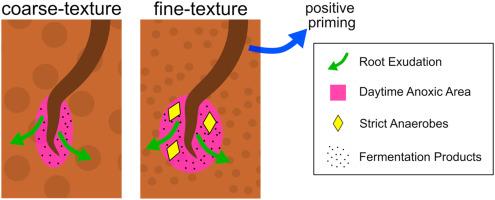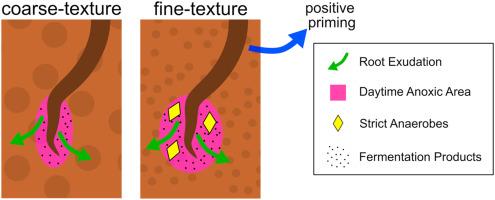Root exudation and fine texture interact to form anoxic microsites in rhizosphere soil
IF 10.3
1区 农林科学
Q1 SOIL SCIENCE
引用次数: 0
Abstract
Anoxic microsites – portions of soil without oxygen in a soil that is otherwise oxic – are important but poorly understood controls on critical biogeochemical processes. Plant roots and, specifically their exudates, are theorized to trigger anoxic microsite formation by stimulating soil microbial activity and subsequent oxygen consumption. However, direct observations of this phenomenon remain limited; even less is known about how root exudates interact with factors regulating oxygen supply, such as soil texture, to regulate rhizosphere oxygen dynamics. Here, we used reverse microdialysis to simulate root exudation in two distinctly textured soils (coarse and fine). We delivered 13C-labeled model root exudates to soil mesocosms over three diurnal cycles and observed that model root exudates increase anoxic volume during the day, particularly in fine-textured soil, and coincide with periods of enhanced soil microbial respiration and positive priming, and thus oxygen consumption. Targeted metabolomics and dPCR further showed that exudate addition increased the abundance of fermentation products and genes associated with anaerobic metabolisms in the rhizosphere. Overall, our results suggest that limited oxygen supply, combined with increased oxygen demand from positive priming and spatially concentrated microbial respiration of root exudates, contributed to greater anoxic microsite formation and quickly provoked anaerobic metabolisms in the rhizosphere of finer-textured soils. Given that root-induced anoxic microsites are rarely considered in biogeochemical cycles in otherwise well-aerated soils, our results inspire questions about the degree to which anoxic microsites mediate the plant influence on carbon cycling, nutrient availability, and contaminant fate in the rhizosphere.


根渗出物与细质地相互作用,在根际土壤中形成缺氧微站点
缺氧微位点是指在含氧土壤中没有氧气的那部分土壤,它们对关键的生物地球化学过程有着重要的控制作用,但人们对它们的理解却很少。植物根系,特别是它们的渗出物,理论上通过刺激土壤微生物活动和随后的氧气消耗来触发缺氧微site的形成。然而,对这一现象的直接观察仍然有限;根分泌物如何与调节氧供应的因素(如土壤质地)相互作用以调节根际氧动力学,我们所知的就更少了。在这里,我们使用反向微透析来模拟两种不同质地土壤(粗土壤和细土壤)的根系渗出。我们将13c标记的模型根分泌物在三个昼夜周期内输送到土壤中胚层,观察到模型根分泌物在白天增加了缺氧量,特别是在细质地土壤中,并且与土壤微生物呼吸和正启动增强的时期相吻合,从而增加了氧气消耗。目标代谢组学和dPCR进一步表明,渗出液的添加增加了根际发酵产物和厌氧代谢相关基因的丰度。总的来说,我们的研究结果表明,有限的氧气供应,加上正启动和根分泌物空间集中的微生物呼吸所增加的氧气需求,促成了更大的缺氧微位点形成,并迅速引发了细质土壤根际的厌氧代谢。鉴于在通气良好的土壤中,根诱导的缺氧微位点很少被考虑在生物地球化学循环中,我们的研究结果激发了关于缺氧微位点在多大程度上介导植物对根际碳循环、养分有效性和污染物命运的影响的问题。
本文章由计算机程序翻译,如有差异,请以英文原文为准。
求助全文
约1分钟内获得全文
求助全文
来源期刊

Soil Biology & Biochemistry
农林科学-土壤科学
CiteScore
16.90
自引率
9.30%
发文量
312
审稿时长
49 days
期刊介绍:
Soil Biology & Biochemistry publishes original research articles of international significance focusing on biological processes in soil and their applications to soil and environmental quality. Major topics include the ecology and biochemical processes of soil organisms, their effects on the environment, and interactions with plants. The journal also welcomes state-of-the-art reviews and discussions on contemporary research in soil biology and biochemistry.
 求助内容:
求助内容: 应助结果提醒方式:
应助结果提醒方式:


